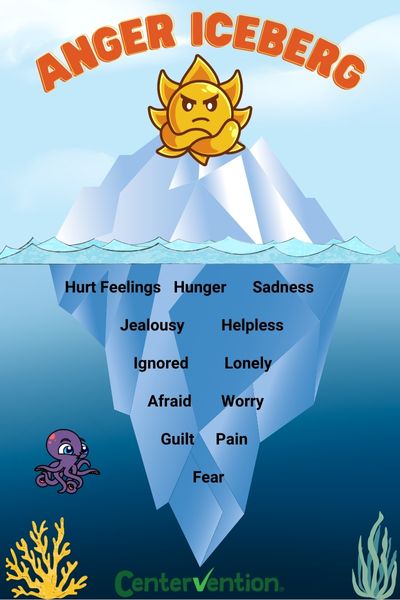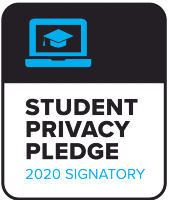The idea of an “anger iceberg” is that our anger is like an iceberg — what we show on the surface is just the tip. But underneath, there are more emotions and beliefs that cause us to feel anger. Just like how most of an iceberg is hidden under the water, our anger may be only a small part of a bigger emotional state. This means that in order to manage our anger we need to look beneath the surface to see what else may be influencing our outlook.
In the lesson below, you will introduce the Anger Iceberg to your students, have them identify specific examples of when they acted angry and had deeper emotions beneath the surface, and finally discuss healthy ways of managing our anger.
Overall, the anger iceberg is a great tool for helping adults and students address the root causes of anger rather than simply reacting to the surface-level emotion.
We also have an Anger Iceberg game that’s a free component of our online Cool Down Corner. You can see more information below.
Recommended Grade Level: Upper Elementary and Middle
SEL Skill(s): Emotion Regulation and Impulse Control
Duration: 30 minutes
Materials: Anger Iceberg Worksheet PDF (Available when logged in to our Centervention educator account).
Anger Iceberg Lesson Instructions
An Anger Iceberg lesson is a great way to teach students about managing their emotions and understanding the underlying causes of their anger. Here are the four steps:
Introduce the Anger Iceberg
Start by explaining the idea of an anger iceberg to your students. You might say something like, “Sometimes when we get angry, there are other feelings and thoughts that we have that we don’t show on the outside. It’s like an iceberg, where most of it is hidden under the water. Let’s think about what might be under the surface when we feel angry.”
Use visuals: Consider using visual aids to help your students understand the concept of the anger iceberg. You could draw an iceberg on the board or project one of the images below:
Discuss Emotions That May Be Causing Anger
Ask your students to think of times when they have felt angry. Encourage them to share what they were feeling and thinking at the time.
You can use any of the examples below to spur discussion or to help younger students understand the concept.
- Fear: Sometimes when we’re scared, we may act out in anger. For example, if a student is afraid of getting in trouble for forgetting their homework, they may become angry and yell at their teacher when reminded about it.
- Frustration: When we’re trying to do something and it doesn’t work out, it can make us frustrated and sometimes angry. For instance, if a student is struggling to solve a math problem, they may become angry and they may feel hot.
- Sadness: Anger can also be a way of hiding sadness or grief. For example, if a student is missing a friend who moved away, they may become angry and lash out at another student to cover up their feelings.
- Insecurity: When we feel unsure of ourselves, we may become defensive and angry. For example, if a student is insecure about their artwork, they may become angry and tear up their drawing when someone makes a negative comment about it.
- Jealousy: Sometimes when we feel like someone else is getting more attention than us, we may become jealous and angry. For example, if a student thinks that their friend is getting more praise from the teacher, they may become angry and start arguing with their friend.
- Hurt: When we feel hurt by someone, we may become angry as a way of protecting ourselves. For example, if a student is hurt because their best friend didn’t invite them to a party, they may become angry and start ignoring their friend at school.
- Disappointment: When things don’t go as we expect them to, we may become angry. For instance, if a student is disappointed that they didn’t get a turn on the swing, they may become angry and cut in front of other students.
- Embarrassment: Sometimes when we feel embarrassed, we may become angry as a way of covering up our embarrassment. For example, if a student accidentally spills their lunch tray in the cafeteria, they may blame someone else for it.
- Guilt: If someone feels guilty about something, they may become angry as a way of avoiding taking responsibility for their actions. For instance, if a student is caught cheating on a test, they may blame the teacher for not explaining the material well enough.
- Powerlessness: When we feel like we have no control over a situation, we may become angry as a way of trying to regain some sense of control. For example, if a student is stuck waiting in line for a long time, they may become angry and start complaining loudly.
Anger Iceberg Worksheet
Provide each student with a copy of the Anger Iceberg worksheet. To complete the worksheet they should:
- At the top of the iceberg, each student should write about something that made them feel very angry and not just mildly annoyed.
- After writing about what made them angry, have them spend a few minutes considering other emotions that they may have felt.
- In the space below the waterline, have them circle the other emotions that they were likely feeling.
Post-Lesson Discussion Topics
Reflection: Once students have completed their worksheets, encourage them to reflect on what they have learned. Ask them to share some of the experiences that made them angry and what they learned about their deeper emotions. Were they surprised to learn that they felt something more than anger?
Discuss coping strategies: Talk with your students about healthy ways to manage their anger. Brainstorm a list of strategies that they can use when they feel angry, such as taking deep breaths, counting to ten, or talking to a trusted friend. Encourage them to use these strategies when they feel themselves getting angry, and to reflect on how they feel after using them.
Online Anger Iceberg Game

As part of our online cool down corner, your students now have access to a free Anger Iceberg pipe building game. This is a great way to reinforce the key elements from the lesson above. Please click the following link to learn more about how to gain access to the Cool Down Corner.
Additional Resources
Books
- What Should Danny Do? by Adir Levy
- Anger Management Skills Workbook for Kids by Amanda Robinson
- Me and My Feelings: by Vanessa Green Allen
- What Were You Thinking? by Bryan Smith
Related Lessons



